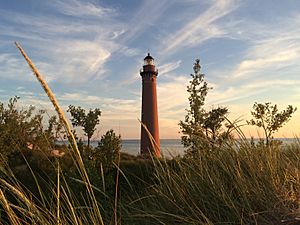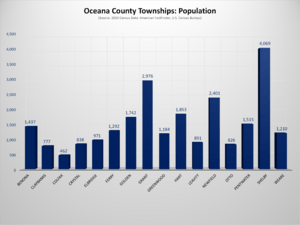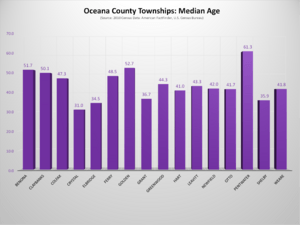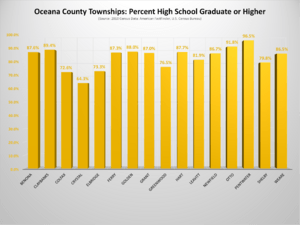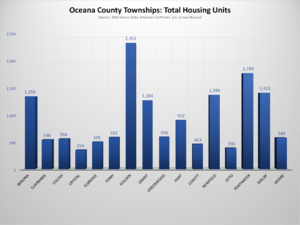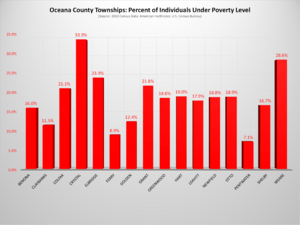Oceana County, Michigan facts for kids
Quick facts for kids
Oceana County
|
||
|---|---|---|
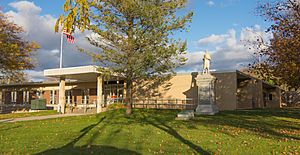
Oceana County Courthouse
|
||
|
||

Location within the U.S. state of Michigan
|
||
 Michigan's location within the U.S. |
||
| Country | ||
| State | ||
| Founded | 1840 (created) 1855 (organized) |
|
| Seat | Hart | |
| Largest city | Hart | |
| Area | ||
| • Total | 1,306 sq mi (3,380 km2) | |
| • Land | 512 sq mi (1,330 km2) | |
| • Water | 794 sq mi (2,060 km2) 61%% | |
| Population
(2020)
|
||
| • Total | 26,659 | |
| • Estimate
(2023)
|
26,981 |
|
| • Density | 20.413/sq mi (7.881/km2) | |
| Time zone | UTC−5 (Eastern) | |
| • Summer (DST) | UTC−4 (EDT) | |
| Congressional district | 2nd | |
Oceana County (/ˌoʊʃiˈænə/ OH-shee-AN-ə) is a county located in the U.S. state of Michigan. As of the 2020 Census, the population was 26,659. Its county seat and largest incorporated community is Hart. Oceana County is located in the West Michigan region of the state's Lower Peninsula. The county has a shoreline along Lake Michigan, which has allowed for agriculture and tourism to flourish within the county. The county is also known as the "Asparagus Capital of the World", and is home to the National Asparagus Festival, in Hart.
Contents
History
Prior to European American settlement, Oceana County was part of the territory of the Ojibwe. Early European American settlers were attracted by access along the White River, which reaches its mouth on Lake Michigan in Muskegon County to the south.
The State of Michigan created the county of Oceana on April 1, 1840. The county was organized in 1855. The origin of the county's name is unclear, although there are two possibilities: the county may have been named for Lake Michigan, the freshwater "ocean," which forms its western border; or for the book Oceana, written by English author James Harrington in 1656.
In the 1850s about 1400 Odawa were relocated here from Ionia County, Michigan by the federal government.
The county economy was first built on the lumber trade, with logs floated downriver. It later was developed for agriculture. In the 21st century, it is known for its commodity crop of asparagus. Oceana County is famous as the "Asparagus Capital of the World" for its high production of asparagus. The annual Asparagus Festival includes a parade and crowning of the Asparagus Queen.
Geography
According to the U.S. Census Bureau, the county has a total area of 1,306 square miles (3,380 km2), of which 512 square miles (1,330 km2) is land and 794 square miles (2,060 km2) (61%) is water. The county is considered to be part of West Michigan. The county's western border is formed by Lake Michigan.
Adjacent counties
By land
- Mason County – north
- Lake County – northeast
- Newaygo County – east
- Muskegon County – south
By water
- Ozaukee County, Wisconsin – southwest
- Sheboygan County, Wisconsin – west
National protected area
- Manistee National Forest (part)
Major highways
 US 31 is a north–south freeway in the west of Oceana County. It passes Rothbury, New Era, Shelby, Mears, Hart, and Pentwater.
US 31 is a north–south freeway in the west of Oceana County. It passes Rothbury, New Era, Shelby, Mears, Hart, and Pentwater.
 Bus. US 31 is a business spur serving downtown Hart.
Bus. US 31 is a business spur serving downtown Hart. M-20 is an east–west route in the south of the county. The highway's western terminus is at US 31 near New Era, and it continues easterly toward Hesperia, where it crosses into Newaygo County.
M-20 is an east–west route in the south of the county. The highway's western terminus is at US 31 near New Era, and it continues easterly toward Hesperia, where it crosses into Newaygo County.- M-120 is a north–south highway that runs due north from the county tri-point with Muskegon and Newaygo counties to an intersection with M-20 at Hesperia.
County-designated highways
 B-15 is a north–south county-designated highway that parallels the shoreline of Lake Michigan. The route enters the county from the south, and passes through Stony Lake and the Silver Lake area before ending at Pentwater.
B-15 is a north–south county-designated highway that parallels the shoreline of Lake Michigan. The route enters the county from the south, and passes through Stony Lake and the Silver Lake area before ending at Pentwater.
Demographics
This rural county reached a peak of population in 2000. It has attracted Hispanic or Latino immigrants who mostly work as farm laborers; in 2010 nearly 14% of the population was Hispanic.
| Historical population | |||
|---|---|---|---|
| Census | Pop. | %± | |
| 1840 | 496 | — | |
| 1850 | 300 | −39.5% | |
| 1860 | 1,816 | 505.3% | |
| 1870 | 7,222 | 297.7% | |
| 1880 | 11,699 | 62.0% | |
| 1890 | 15,698 | 34.2% | |
| 1900 | 16,644 | 6.0% | |
| 1910 | 18,379 | 10.4% | |
| 1920 | 15,601 | −15.1% | |
| 1930 | 13,805 | −11.5% | |
| 1940 | 14,812 | 7.3% | |
| 1950 | 16,105 | 8.7% | |
| 1960 | 16,547 | 2.7% | |
| 1970 | 17,984 | 8.7% | |
| 1980 | 22,002 | 22.3% | |
| 1990 | 22,454 | 2.1% | |
| 2000 | 26,873 | 19.7% | |
| 2010 | 26,570 | −1.1% | |
| 2020 | 26,659 | 0.3% | |
| 2023 (est.) | 26,981 | 1.5% | |
| US Decennial Census 1790-1960 1900-1990 1990-2000 2010-2018 |
|||
The 2010 United States Census indicates Oceana County had a 2010 population of 26,570. This decrease of 303 people from the 2000 United States Census represents a 1.1% population decrease in the decade. In 2010 there were 10,174 households and 7,239 families in the county. The population density was 51.9 per square mile (20.0 square kilometers). There were 15,944 housing units at an average density of 31.1 per square mile (12.0 square kilometers). The racial and ethnic makeup of the county was 83.7% White, 0.4% Black or African American, 0.8% Native American, 0.2% Asian, 13.7% Hispanic or Latino, 0.1% from other races, and 1.2% from two or more races.
There were 10,174 households, out of which 30.4% had children under the age of 18 living with them, 56.6% were husband and wife families, 9.5% had a female householder with no husband present, 28.8% were non-families, and 24.6% were made up of individuals. The average household size was 2.58 and the average family size was 3.04.
The county population contained 24.9% under age of 18, 7.5% from 18 to 24, 21.5% from 25 to 44, 29.0% from 45 to 64, and 17.0% who were 65 years of age or older. The median age was 42 years. For every 100 females there were 100.9 males. For every 100 females age 18 and over, there were 99.3 males.
The 2010 American Community Survey 3-year estimate indicates the median income for a household in the county was $39,043 and the median income for a family was $46,816. Males had a median income of $21,774 versus $14,186 for females. The per capita income for the county was $18,065. About 1.9% of families and 19.0% of the population were below the poverty line, including 30.4% of those under the age 18 and 11.3% of those age 65 or over.
Religion
- Oceana County is part of the Roman Catholic Diocese of Grand Rapids.
- Oceana County is part of the Episcopal Diocese of Western Michigan.
- Several Christian denominations are represented in the county population.
- There is one meetinghouse of the Church of Jesus Christ of Latter-day Saints in Oceana County as of 2018.
Tourism
The Electric Forest Festival (formerly the Rothbury Music Festival) has been held annually in Rothbury, Michigan since 2008, except 2020 and 2021, due to COVID.
Camping is a popular summer activity in Oceana County. Areas on the lakeshore such as Silver Lake, Pentwater, and Stony Lake are popular tourist sites.
Education
The West Shore Educational Service District, based in Ludington, services the districts in the county along with those of Mason and Lake counties. The intermediate school district offers regional special education and general education services, as well as technical career programs for its students.
Oceana County is served by the following regular public school districts:
- Hart Public School District
- Pentwater Public School District
- Shelby Public Schools
- Walkerville Public Schools
Oceana County has the following private schools:
- New Era Christian School
- Oceana Christian School (Baptist)
Communities
City
- Hart (county seat)
Villages
Census-designated place
Unincorporated communities
- Bird
- Collinsville
- Corbin's Mill
- Cranston
- Crystal Valley
- Elbridge
- Elmwood
- Elwood
- Ferry
- Flower Creek
- Forest City
- Gale
- Silver Lake
- Stony Lake
Townships
- Benona Township
- Claybanks Township
- Colfax Township
- Crystal Township
- Elbridge Township
- Ferry Township
- Golden Township
- Grant Township
- Greenwood Township
- Hart Township
- Leavitt Township
- Newfield Township
- Otto Township
- Pentwater Township
- Shelby Township
- Weare Township
See also
 In Spanish: Condado de Oceana para niños
In Spanish: Condado de Oceana para niños



